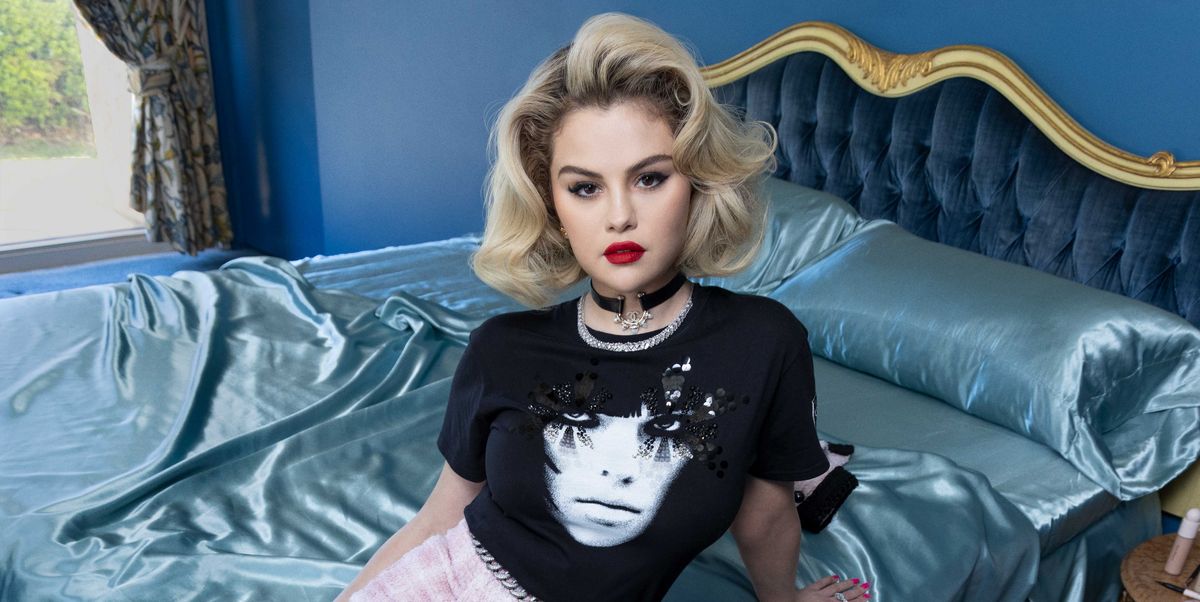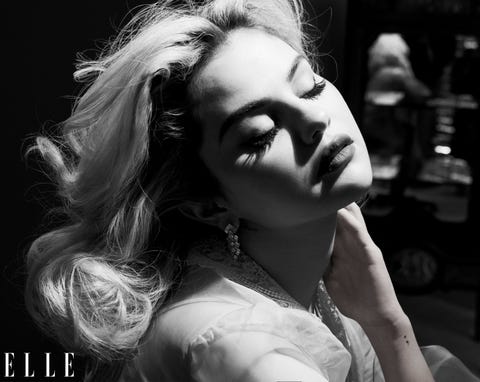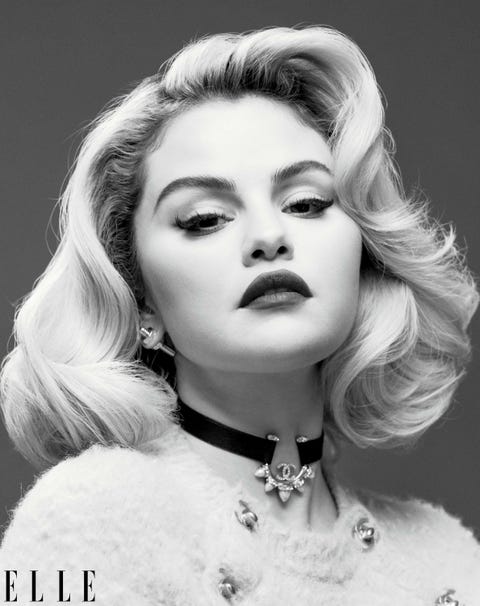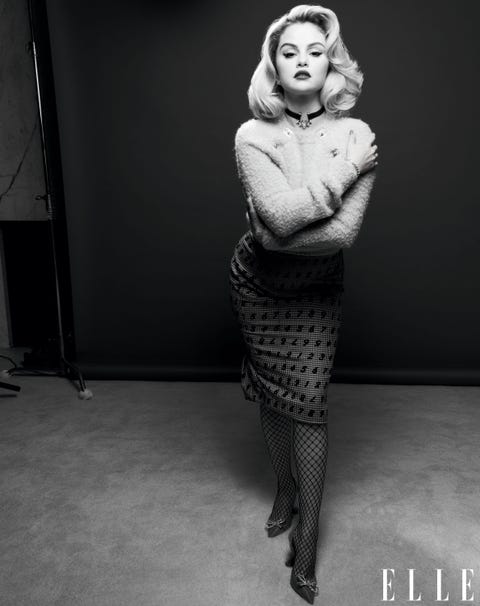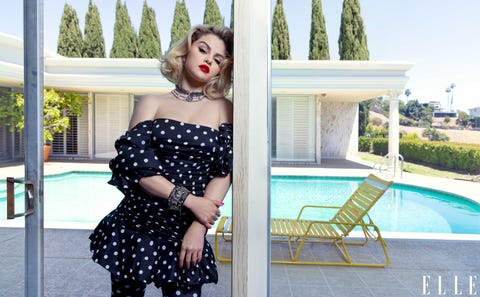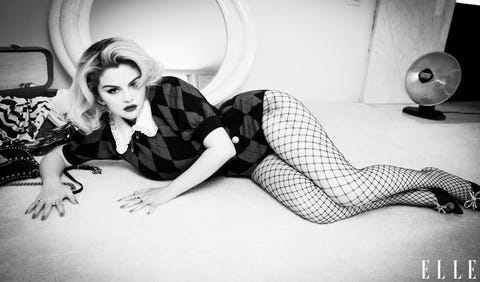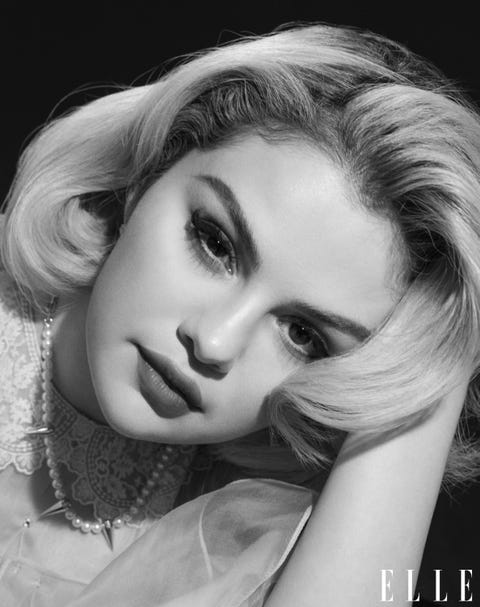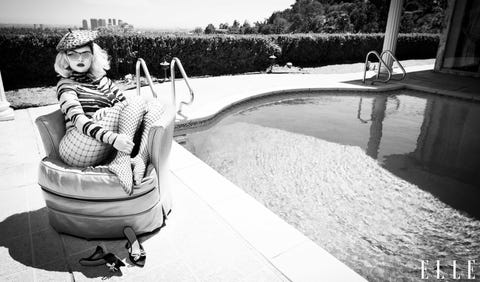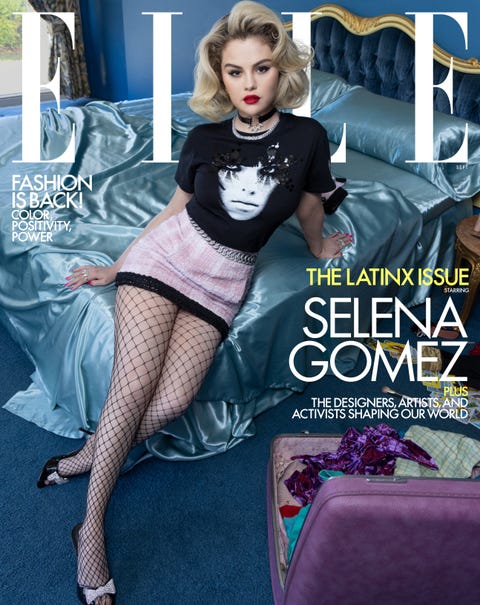Selena Gomez’s favorite place to chill is her glam room. A small space on the ground floor of her new L.A.-area house, it opens onto a stone patio surrounding an amoeba-shaped pool. Inside, there’s a hair and makeup station stocked with products from her Rare Beauty line; racks of clothes for her cooking show, Selena + Chef; a selection of shoes on a shoebox dais; a green velvet couch; a couple of salon chairs; a large-screen TV; a mini-fridge; and a snack station. Gomez meets me there dressed in a fuzzy light gray sweater, black leggings, and white sneakers, her hair pulled back into a ponytail. She, her roommates, and her maternal grandparents—who lived with her prior to quarantine—spend a lot of time down here watching basketball and hanging out.
Gomez moved into the house shortly before the pandemic, having recently sold two previous homes. “I tried out a bunch of different neighborhoods because I wanted to know what was going to make me feel comfortable in a city that doesn’t make me feel that comfortable,” she says. “I was like, ‘Oh, maybe I’ll try West Hollywood,’ but I was like, ‘No, that’s not my vibe.’ Then I moved to Calabasas, and I thought that would be nice and family-oriented, but it’s actually very overwhelming and trendy now. It took me a while to figure out what was best for me.”
The house she finally settled on has a cozy, eclectic, collective vibe—kind of like a ski chalet, or a sorority. “I’m a very communal person,” Gomez says. “I find happiness when I’m with people I love.” Considering the challenges she has faced in the past decade, it’s hardly surprising that she feels most at home surrounded by close family and friends. “My lupus, my kidney transplant, chemotherapy, having a mental illness, going through very public heartbreaks—these were all things that honestly should have taken me down,” she says. Gomez speaks slowly and calmly, in a surprisingly low and uninflected register. “Every time I went through something, I was like, ‘What else? What else am I going to have to deal with?’ ” “ ‘You’re going to help people,’ ” she told herself. “That’s really what kept me going. There could have been a time when I wasn’t strong enough, and would have done something to hurt myself.”
To say the past decade has been hard for Gomez is a massive understatement. But it’s also been incredibly generative. During the pandemic, while most of us were eating Double Stuf Oreos all day in our pajamas, Gomez was busy shooting the new Hulu show Only Murders in the Building (her first series-regular role since Wizards of Waverly Place). Starring alongside Steve Martin and Martin Short, Gomez, who is also an executive producer, plays Mabel, a lonely young woman who lives in a luxury Upper West Side apartment building. When a resident is found murdered, she meets her neighbors and fellow true-crime fans Charles and Oliver (Martin and Short), and the three of them decide to investigate and create their own podcast, mostly as an excuse to spend time together.
- BEAUTY TIP: Paint a super sharp wing with Rare Beauty Perfect Strokes Matte Liquid Liner.
When Only Murders started shooting last November, Gomez was excited, but COVID protocols made it stressful. “No one was allowed to be on set. Everybody wore masks and shields. If I touched a prop, they cleaned it,” she says. For a kissing scene, she was required to wash her mouth out with Listerine after each take—7 to 10 of them. “It burned my mouth. I was like, ‘I want to throw up.’ I’ve never experienced a set like that.”
“She’s a brilliant actress,” Martin Short tells me over the phone. “And there’s an immediate warmth and loveliness to her.” She impressed Steve Martin, too. “Marty and I were both knocked out by her understanding that quiet acting is powerful acting,” he says, adding, “Marty doesn’t yet understand this.”
The three of them bonded instantly, their dynamic on set reflecting their playful dynamic onscreen. Gomez, for instance, took it upon herself to educate Martin on certain cultural developments.
“There was a line in the script that said, ‘She’s an OG.’ And Steve walked up and said, ‘Can somebody tell me what OG means?’ ” she says. “I started dying laughing.” On another occasion, she taught him the lyrics to “WAP.” “Steve said, ‘Marty, I just heard new lyrics to “Top Hat and Tails,” ’ ” Short recalls.
Gomez loved working with the older actors. “I got to be in a space with so much wisdom,” she says. “They became my uncles.” Martin echoed the sentiment: “We ended up feeling very close to Selena.”
Only Murders wasn’t the only show she shot during quarantine. Selena + Chef was inspired by the food people were posting and Gomez’s inability to make it. “Everyone got so involved in cooking during the pandemic,” she says. She found herself looking at pictures of food, wishing she knew how to prepare it.
So, as one does—if one is Selena Gomez—she called her team and asked what she could do during quarantine that would allow her to have fun with cooking. Shortly thereafter, Selena + Chef was born. In the intro, groceries arrive on her doorstep, and when she goes to get them, she mumbles, “This is what I’m going to burn today.” Then a famous chef appears (remotely) in her kitchen. So far, she’s cooked with Nancy Silverton, Ludo Lefebvre, and Antonia Lofaso, among others. Gomez’s kitchen is outfitted with cameras and a large-screen TV, which is split between the chef ’s face and their hands. Gomez tries to keep up while smiling and bantering. “Then I pull it out of the oven, and I’m like, ‘This is what it looks like.’ ” She feeds the results to her grandparents and roommates.
- BEAUTY TIP: A classic ruby lip, like Rare Beauty Lip Soufflé Matte Lip Cream in Inspire, is always a bright idea.
The show makes her happy. In addition to feeding her philanthropic goals (the show has raised $360,000 for 23 nonprofit organizations during just the first two seasons), it has helped her connect with fans in a very authentic way. “It’s the most ‘myself ’ I’ve been to the world,” she says. She realizes she may not be the most talented cook, but she does it anyway. She’s doing her best. Fans have approached her to say, “It’s really awesome that you make mistakes.”
It took time for Gomez, who has lived her life in the public eye since she was seven, to be this comfortable showing vulnerability. The former child star, who became a household name when she starred in the Disney Channel show Wizards of Waverly Place, struggled with the lack of privacy and constant media presence in her life. “For a while, I felt like an object,” she says. “It felt gross for a long time.”
The first time Gomez sought treatment for mental health, soon after she’d been diagnosed with lupus in 2014, some assumed she’d gone to rehab for substance abuse. “I don’t even know what they really believed I was doing—drugs, alcohol, running around, partying. The narrative was so nasty.”
So Gomez decided to flip the script. She posted a caption on Instagram that read, “I want to claim back my name.” She talked openly about her struggles: “Yes, I went away. Yes, I struggle with mental health. I’ve been depressed, and I’ve had anxiety.” In 2018, Gomez was diagnosed with bipolar disorder. “I felt a huge weight lifted off me when I found out,” she says. “I could take a deep breath and go, ‘Okay, that explains so much.’ ”
One way Gomez has taken control of her mental health is by letting go of social media. Four years ago, she was the most-followed person on Instagram. And yet, while beloved by millions of fans, she struggled with the negativity that often surfaced in the comments. She asked her-self, “What’s the purpose of this?” Visiting kids in hospital wards, having fans come up to her to say how “Lose You to Love Me” has helped them through a divorce—these things meant more to her than say, posting a random picture of her nails. “I’m like, ‘I’ve got to do something [more]. After I’m gone, I want people to remember me for my heart.’ ” And so, in 2017, she handed the reins (and passwords) of her social media accounts to her assistant. She still provides photos and quotes, but she no longer posts directly herself. “I don’t have it on my phone, so there’s no temptation. I suddenly had to learn how to be with myself. That was annoying, because in the past, I could spend hours looking at other people’s lives. I would find myself down nearly two years in someone’s feed, and then I’d realize, ‘I don’t even know this person!’ Now I get information the proper way. When my friends have something to talk about, they call me and say, ‘Oh, I did this.’ They don’t say, ‘Wait, did you see my post?’ ”
Eschewing social media cleared mental space, allowing Gomez to focus on projects and causes that spoke to her on a deeper level. “It was so nice,” she says. “I felt like I was suddenly able to be so present.” She began developing Rare Beauty, a collection of makeup that’s all about embracing your natural beauty and rejecting unrealistic standards of perfection. “I’ve spent years of my life trying to look like other people. I would see an image, and I would be like, ‘My gosh, why don’t I look like that?’ None of that was good for me.” With Rare Beauty, she wants to empower women to wear makeup because they want to, not because they need to. And like all her ventures, the brand has a charitable side: the Rare Impact Fund, which aims to raise $100 million over the next 10 years to improve access to mental health services. “Everything that I’m attached to has a charity aspect. If something good isn’t coming out of it, I’m not going to do it. I don’t need money,” she says. “I need people who want to fight with me.”
She brought the same fighting spirit to Instagram. Recognizing that she had a powerful platform—even without her micromanaging it every day—she decided to use her account for social good. Prior to the last election, Gomez had never voted, and she began thinking about why it had seemed so difficult. “At first it was just me educating people on the voting process,” she says. She became involved with the organization When We All Vote and joined Michelle Obama’s “Voting Squad,” lending her Instagram to activists, philanthropists, teachers, therapists, and psychologists. The chaos of the last administration also led her to reflect on her Mexican American heritage in ways she hadn’t before. She thought about the racism she’d experienced firsthand with her father. “Growing up, we didn’t have much, and we were treated poorly. My dad would get pulled over all the time, and he wasn’t doing anything most of the time.” Once, at a Shania Twain concert in Dallas, someone (who clearly didn’t recognize her) called him a “wetback.” Gomez was apoplectic. “I wanted to show him my Instagram!” she jokes wryly. But her dad talked her down. “ ‘There’s nothing we can do,’ ” she recalls him telling her at the time. “ ‘It’s just going to start more trouble for me, not them. We could get kicked out of this place.’ ”
Nowadays, Gomez is channeling her indignation into action, using her platform to campaign against misinformation and hate speech and raising awareness about human trafficking and the plight of undocumented immigrants on Living Undocumented, the Netflix documentary series she helps executive produce. She is also using her power and position to celebrate fellow Latinx superstars. Case in point: In the Shadow of the Mountain, a biopic she is producing and starring in about Silvia Vásquez-Lavado, a Peruvian entrepreneur and part-time mountaineer, and the first openly gay woman to scale the Seven Summits.
In March of this year, Gomez found another way to connect her Latinx community: Revelación, her first record in Spanish. The pandemic provided the perfect pause she needed to get this project off the ground. “It was a challenge,” she says. “I think speaking in Spanish is a lot easier than singing.” But with a bit more time on her hands than usual, Gomez was able to work with a Spanish coach and really nail it. “I made sure that I didn’t look like a fool,” she says. “I focused so hard on making sure that the language I was speaking, and the way I was speak-ing it, was authentic. I wanted it to exude love—to talk about pain, but in a way that was confident. There is a song about girls saying goodbye to things that aren’t good for us.”
Several months ago, Gomez told a reporter that she was considering quitting music; she doesn’t feel like she’s taken seriously as a musician. But when asked about it now, she demurs. “I don’t think I’ll ever quit making music,” she says. But, she admits, she does still feel like she’s constantly trying to prove herself. “I’m not saying I want a Grammy. I just feel like I’m doing the best I can, and it’s all about me. Sometimes, that can really get to me.” Music, unlike acting, is so personal, she says: “You’re pouring yourself out.” Getting off Instagram has helped stanch the emotional flow—and given her the space to take more creative risks. “This tiny little phone that had 150 million people on it–I just put it down,” she says. “That was such a relief for me.”
Hair by Orlando Pita for Orlo Play; Makeup by Hung Vanngo at The Wall Group; Nails by Lisa Peña-Wong for Chanel; Set Design by James Chinlund at The Magnet Agency; Produced by Gabe Hill at GE Projects
This article appears in the September 2021 issue of ELLE.
